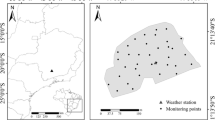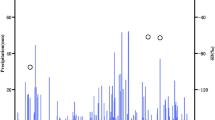Abstract
Stemflow of xerophytic shrubs represents a significant component of water replenishment to the soil-root system and influences water utilization of plant roots at the stand scale, especially in water-scarce semi-arid ecosystems. The stemflow of two semi-arid shrubs (Caragana korshinskii and Hippophae rhamnoides) and its effect on soil moisture enhancement were evaluated during the growing season of 2011 in the semi-arid loess region of China. The results indicated that stemflow averaged 12.3% and 8.4% of the bulk precipitation for C. korshinskii and H. rhamnoides, respectively. Individual stemflow increased in a linear function with increasing rainfall depth. The relationship between funneling ratios and rainfall suggested that there existed a rainfall depth threshold of 11 mm for both C. korshinskii and H. rhamnoides. Averaged funneling ratios were 156.6±57.1 and 49.5±30.8 for C. korshinskii and H. rhamnoides, respectively, indicating that the canopy architecture of the two shrubs was an effective funnel to channel stemflow to the root area, and C. korshinskii showed a greater potential to use stemflow water in the semi-arid conditions. For individual rainfall events, the wetting front depths were approximately 2 times deeper in the rooting zone around the stems than in the bare area outside canopy for both C. korshinskii and H. rhamnoides. Correspondingly, soil water content was also significantly higher in the root area around the shrub stem than in the area outside the shrub canopy. This confirms that shrub stemflow conserved in the deep soil layers may be an available moisture source for plant growth under semi-arid conditions.
Similar content being viewed by others
References
Aboal J R, Morales D, Hernandez M, et al. 1999. The measurement and modelling of the variation of stemflow in a laurel forest in Tenerife, Canary Islands. Journal of Hydrology, 221(3–4): 161–175.
Adams M, Angradi T. 1996. Decomposition and nutrient dynamics of hardwood leaf litter in the Fernow whole-watershed acidification experiment. Forest Ecology and Management, 83(1–2): 61–69.
Belmonte S F, Romero D A. 1998. A simple technique for measuring rainfall interception by small shrub: “interception flow collection box”. Hydrological Processes, 12(3): 471–481.
Bui E N, Box J E. 1992. Stemflow, rain throughfall, and erosion under canopies of corn and sorghum. Soil Science Society of America Journal, 56(1): 242–247.
Cape J N, Brown A F H, Robertson S M C, et al. 1991. Interspecies comparisons of throughfall and stemflow at three sites in northern Britain. Forest Ecology and Management, 46(3–4): 165–177.
Carlisle A, Brown A H F, White E J. 1966. The organic matter and nutrient elements in the precipitation beneath a sessile oak (Quercus petraea) canopy. The Journal of Ecology, 54(1): 87–98.
Carlyle-Moses D E. 2004. Throughfall, stemflow, and canopy interception loss fluxes in a semi-arid Sierra Madre Oriental matorral community. Journal of Arid Environments, 58(2): 181–202.
Carlyle-Moses D E, Price A G. 2006. Growing-season stemflow production within a deciduous forest of southern Ontario. Hydrological Processes, 20(17): 3651–3663.
Crockford R H, Richardson D P. 1990. Partitioning of rainfall in a eucalypt forest and pine plantation in southeastern Australia: II Stemflow and factors affecting stemflow in a dry sclerophyll eucalypt forest and a Pinus radiata plantation. Hydrological Processes, 4(2): 145–155.
Durocher M G. 1990. Monitoring spatial variability of forest interception. Hydrological Processes, 4(3): 215–229.
Enright N J. 1987. Stemflow as a nutrient source for nikau palm (Rhopalostylis sapida) in a New Zealand forest. Australian Journal of Ecology, 12(1): 17–24.
Ford E D, Deans J D. 1978. The effects of canopy structure on stemflow, throughfall and interception loss in a young Sitka spruce plantation. Journal of Applied Ecology, 15(3): 905–917.
Forrer I, Papritz A, Kasteel R, et al. 2000. Quantifying dye tracers in soil profiles by image processing. European Journal of Soil Science, 51(2): 313–322.
Gómez J A, Vanderlinden K, Giraldez J V, et al. 2002. Rainfall concentration under olive trees. Agricultural Water Management, 55(1): 53–70.
Herwitz S R. 1985. Interception storage capacities of tropical rainforest canopy trees. Journal of Hydrology, 77(1–4): 237–252.
Herwitz S R. 1986. Infiltration-excess caused by stemflow in a cyclone-prone tropical rainforest. Earth Surface Processes and Landforms, 11(4): 401–412.
Herwitz S R. 1987. Raindrop impact and water flow on the vegetative surfaces of trees and the effects on stemflow and throughfall generation. Earth Surface Processes and Landforms, 12(4): 425–432.
Jabro J D, Lotse E G, Simmons K E, et al. 1991. A field study of macropore flow under saturated conditions using a bromide tracer. Journal of Soil and Water Conservation, 46(5): 376–380.
Johnson M S, Lehmann J. 2006. Double-funneling of trees: stemflow and root-induced preferential flow. Ecoscience, 13(3): 324–333.
Leonard R E. 1961. Net precipitation in a northern hardwood forest. Journal of Geophysical Research, 66(8): 2417–2421.
Levia D F, Frost E E. 2003. A review and evaluation of stemflow literature in the hydrologic and biogeochemical cycles of forested and agricultural ecosystems. Journal of Hydrology, 274(1–4): 1–29.
Li X Y, Liu L Y, Gao S Y, et al. 2008. Stemflow in three shrubs and its effect on soil water enhancement in semiarid loess region of China. Agricultural and Forest Meteorology, 148(10): 1501–1507.
Li X Y, Yang Z P, Li Y T, et al. 2009. Connecting ecohydrology and hydropedology in desert shrubs: stemflow as a source of preferential flow in soils. Hydrology and Earth System Sciences, 13: 1133–1144.
Liu S. 1998. Estimation of rainfall storage capacity in the canopies of cypress wetlands and slash pine uplands in North-Central Florida. Journal of Hydrology, 207(1–2): 32–41.
Llorens P, Gallart F. 2000. A simplified method for forest water storage capacity measurement. Journal of Hydrology, 240(1–2): 131–144.
Llorens P, Domingo F. 2007. Rainfall partitioning by vegetation under Mediterranean conditions. A review of studies in Europe. Journal of Hydrology, 335(1–2): 37–54.
Martinez-Meza E, Whitford W G. 1996. Stemflow, throughfall and channelization of stemflow by roots in three Chihuahuan desert shrubs. Journal of Arid Environments, 32(3): 271–287.
Návar J, Bryan R. 1990. Interception loss and rainfall redistribution by three semi-arid growing shrubs in northeastern Mexico. Journal of Hydrology, 115(1–4): 51–63.
Návar J. 1993. The causes of stemflow variation in three semi-arid growing species of northeastern Mexico. Journal of Hydrology, 145(1–2): 175–190.
Návar J. 2011. Stemflow variation in Mexico’s northeastern forest communities: its contribution to soil moisture content and aquifer recharge. Journal of Hydrology, 408(1–2): 35–42.
Nulsen R A, Bligh K J, Baxter I N, et al. 1986. The fate of rainfall in a mallee and heath vegetated catchment in southern Western Australia. Australian Journal of Ecology, 11(4): 361–371.
Pereira F L, Gash J H C, David J S, et al. 2009. Modelling interception loss from evergreen oak Mediterranean savannas: application of a tree-based modelling approach. Agricultural and Forest Meteorology, 149(3–4), 680–688.
Pressland A J. 1973. Rainfall partitioning by an arid woodland (Acacia aneura F. Muell.) in south-western Queensland. Australian Journal of Botany, 21(2): 235–245.
Taniguchi M, Tsujimura M, Tanaka T. 1996. Significance of stemflow in groundwater recharge. 1: evaluation of the stemflow contribution to recharge using a mass balance approach. Hydrological Processes, 10(1): 71–80.
Tromble J. 1988. Water interception by two arid land shrubs. Journal of Arid Environments, 15(2): 65–70.
Voigt G K. 1960. Distribution of rainfall under forest stands. Forest Science, 6(1): 2–10.
Voigt G K, Zwolinski M J. 1964. Absorption of stemflow by bark of young red and white pines. Forest Science, 10(3): 277–282.
Wang X P, Li X R, Xiao H L, et al. 2007. Effects of surface characteristics on infiltration patterns in an arid shrub desert. Hydrology Process, 21(1): 72–79.
Wang X P, Cui Y, Pan Y X, et al. 2008. Effects of rainfall characteristics on infiltration and redistribution patterns in revegetation-stabilized desert ecosystems. Journal of Hydrology, 358(1–2): 134–143.
Weiler M, Flühler H. 2004. Inferring flow types from dye patterns in macroporous soils. Geoderma, 120(1–2): 137–153.
Whitford W G, Anderson J, Rice P M. 1997. Stemflow contribution to the ‘fertile island’ effect in creosotebush, Larrea tridentata. Journal of Arid Environments, 35(3): 451–457.
Wood M K, Jones T L, Vera-Cruz M T. 1998. Rainfall interception by selected plants in the Chihuahuan Desert. Journal of Range Management, 51(1): 91–96.
Author information
Authors and Affiliations
Corresponding author
Rights and permissions
About this article
Cite this article
Jian, S., Zhao, C., Fang, S. et al. Characteristics of Caragana korshinskii and Hippophae rhamnoides stemflow and their significance in soil moisture enhancement in Loess Plateau, China. J. Arid Land 6, 105–116 (2014). https://doi.org/10.1007/s40333-013-0189-4
Received:
Revised:
Accepted:
Published:
Issue Date:
DOI: https://doi.org/10.1007/s40333-013-0189-4




